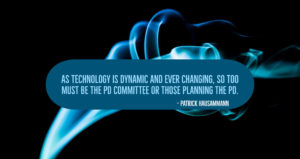Part II
Interspersed between formal PD sessions should be team, departmental, and informal meetings that build-in time for collaborative iteration of not just actual classroom implementation of learned concepts, but also refinement of the upcoming PD sessions based on feedback (both to sessions and to surveys regarding implementation) and observations.
Ongoing and frequent assessment of PD is critical to its long term success. No PD plan will truly yield worthwhile results if it is not assessed in multiple ways and, Guskey (2002), outlines five levels of evaluation that can provide a full window into the effectiveness of PD. Participants’ reaction, learning, and use of new knowledge and skills are measured alongside the organization support and change with the ultimate goal of student learning outcomes kept in the forefront at all times in assessment (Guskey, 2002).
Surveys evaluating PD sessions should be given during the end part of each session before attendees leave. These surveys should address participants’ reactions, learning, and feelings regarding organization support. Meetings (team, content area, etc.) should also be used to add to these areas of PD assessment, however, they will be used more to assess through reflection participants’ use of new knowledge and skills. In addition, professional learning community (PLCs) meetings within the building with PD committee members could serve to support all participants, provide ongoing assessment, and increase the likelihood of the PD being successful. All these types of meetings alongside observations will prove valuable in assessing the PD in the area of actual classroom implementation of new skills and knowledge. Anecdotal evaluation mainly through informal conversations will prove valuable in nearly every area of the assessment process. The hardest part to measure for the PD will be student learning outcomes. Standardized testing scores can be used to show improvement alongside other normed assessments. However, it will be important to try and isolate other measures that could have contributed (i.e. new review measures, software, etc.). In the end, improvement measures here may come from more qualitative sources than quantitative.
Following assessment, revising PD should be frequent and completed in response to assessment measures of the previous session through meetings of the PD committee or providers with attendee input. Revisions should occur before every formal session following session one; no session should be the same or cover the material in the same way (unless it is reviewed/reflected upon as the best practice by attendees). As technology is dynamic and ever changing, so too must be the PD committee or those planning the PD. It will be key to change only the most critical pieces so as to not overwhelm teachers with too much constant change. Changes may be in the way sessions are presented and run or they may be in the resources provided depending on the needs of the school community. Through their participation in assessment measures revision can be precise and substantive. Finally, The PD providers must continually seek the most current research and best practices to present to teachers alongside tools that can aid in the meaningful integration of technology for increased teacher and student growth and achievement.

Patrick B. Hausammann, M.S. Ed.
Perpetual optimist and believer in the power of a #growthmindset to #failfoward. Co-Founder of #EdcampNSV and Certified #GoogleET, Admin, & Educator 1 & 2.
Website: www.epedtech.com
Twitter: @PHausTech
